Exploring the Inner Game of Tennis: Insights & Applications

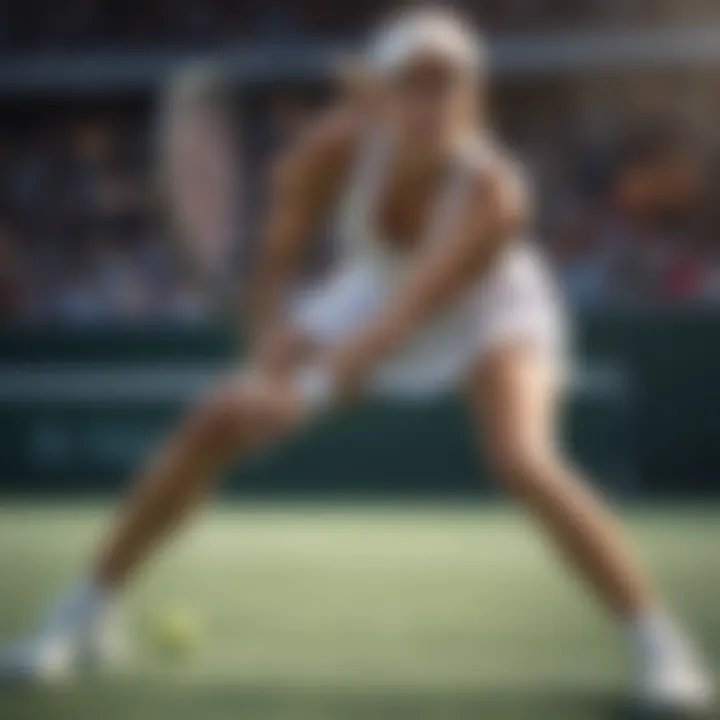
Intro
When contemplating the game of tennis, the physical element often takes center stage. The dramatic serves, strategic volleys, and sweat-drenched rallies tend to overshadow another crucial aspect: the mental game. W. Timothy Gallwey’s seminal work introduces a paradigm shift that compels players and enthusiasts alike to reconsider their approach.
It isn’t just about the racquet, the court, or even the score. The underlying principles can seep into various facets of our lives, urging a more profound keen-ness for self-awareness and focused attention. This exploration aims to unravel these intricate layers, merging the worlds of sports and personal growth.
Key Concepts and Insights
Main Ideas from the Book
Gallwey's text articulates the concept of the "inner game," a term that refers to the mental struggles faced within oneself. While onlookers may cheer for a spectacular shot, they rarely witness the silent battle occurring in the player’s mind. He posits that performance isn’t merely dictated by physical prowess but rather by the mental state one cultivates.
"The greatest enemy of the player is the player himself."
This quote captures the essence of his argument: negative self-talk, doubts, and distractions can significantly affect success. Gallwey scrutinizes how players often impose limits through their own mindset. By learning to quiet these disturbances and focus on execution, one can optimize performance.
Additionally, he introduces practical techniques such as visualization and breathing exercises. These methods serve as gateways to enhance concentration, urging the person to be fully present, akin to being in "the zone." To illustrate:
- Visualization: Imagine yourself executing a flawless serve.
- Breathing Exercises: Take deep breaths to center your mind during high-pressure moments.
Practical Applications of Concepts
The relevance of Gallwey's insights stretches into daily life, well beyond the tennis court. The ideas can apply to various realms: work, education, and personal relationships. For instance, in the workplace, recognizing inner dialogue and managing stress can lead to improved productivity and creativity. Implementing focused attention methods can help individuals stay engaged and reduce feelings of overwhelm.
In the context of education, students can benefit from understanding how to cultivate self-awareness. By applying the principles of the inner game, learners are encouraged to cultivate resilience and grit, essential skills in any scholarly pursuit.
Moreover, the very act of playing a game or sport can serve as an excellent metaphor for life. When faced with challenges—be it in sports or in personal decisions—the framework that Gallwey delineates encourages strategic thinking and emotional regulation.
Recommendations and Further Reading
Related Books to Explore
- "The Talent Code" by Daniel Coyle
- "Mindset: The New Psychology of Success" by Carol S. Dweck
- "The Inner Game of Work" by W. Timothy Gallwey
Additional Resources for Personal Development
- Wikipedia - The Inner Game of Tennis
- Britannica - Inner Game
- Reddit - Discussions on Gallwey's Concepts
- Facebook - Community on Mental Performance
Through this discourse, readers are invited to reflect on how the core themes of Gallwey’s work intersect their own experiences, prompting a richer appreciation for the nuances that shape our actions and achievements.
Preamble to the Inner Game
Delving into the intricacies of tennis, one can quickly recognize that it is not merely a physical game; there exists a mental battleground that can often dictate the outcome. This article endeavors to explore the concepts put forth by W. Timothy Gallwey in his renowned work on the inner game of tennis. Understanding the interplay between thought and action transcends the sport itself, revealing insights applicable to various aspects of life.
Gallwey’s concepts address the dual nature of self—what he calls Self One and Self Two. Recognizing how these selves interact sheds light on performance and self-awareness. Focusing on how to cultivate a strong mental game is crucial for any individual aiming to reach their peak performance. Practicing this form of self-awareness helps in identifying patterns of thought that may inhibit success.
Indeed, the importance of the inner game goes beyond just sneaking by on the tennis court. The journey through mastering one’s mental faculties can lead to significant transformations in everyday life, from improved decision-making to greater emotional resilience. Hence, reflecting on this inner journey can open up new avenues for self-discovery and personal growth.
"The mind is everything. What you think you become." – Buddha
Understanding this nexus of thought and action offers not just a toolkit for athletes but also a framework for anyone wishing to enhance their lives. The principles of focus, trust, and visualization observed in tennis provide a template for navigating various challenges life throws our way. As we move through the sections of this article, it is essential to keep a lookout for nuggets of wisdom that can serve both on and off the court.
Understanding the Two Selves
The concept of Understanding the Two Selves forms a cornerstone in the exploration of the mental aspects of tennis outlined in W. Timothy Gallwey's work. At its heart, this idea delves into the inherent conflict between two aspects of our being during performance: Self One and Self Two. Recognizing and unpacking this dichotomy not only enhances tennis skills but also fosters broader personal and professional growth.
The Self One and Self Two Dichotomy
Self One represents the thinking self. It's the part of us that analyzes, evaluates, and sometimes even critiques our actions. Imagine preparing for a serve in tennis; that inner voice is loud, saying things like, "Don’t double fault this time!" or "What if you miss this shot?" This part can, at times, be our worst enemy, filling us with doubts and anxieties that can paralyze our performance.
On the flip side, Self Two embodies the doer. This self is instinctual, relying on muscle memory and intuitive actions honed through repetition and practice. When you think back to a moment when everything fell into place during a match—perhaps hitting a perfect backhand down the line without overthinking it—that's Self Two at work, free from the paralysis of Self One’s critical inner dialog.
The tension between these two selves is palpable on the court. When they clash, as many players can attest, performance often suffers. Recognizing when Self One is taking the reins is crucial. Just like a bird trying to fly with a broken wing, our performance can falter if we let thinking overshadow doing.
To gain mastery in tennis and even in wider life experiences, it’s essential to effectively manage these two selves, ensuring Self Two has the freedom to act. This balance can lead to an enhanced state of flow, where actions become fluid and effortless.
Interactions Between the Two Selves
Understanding the interplay between Self One and Self Two can be revelatory. They exist in a constant dialogue, influencing our actions and perceptions. One key consideration is how Self One can actually serve as a guide rather than a detriment. For instance, when Self One helps set goals, reflecting on techniques or strategies, it can promote better execution.
However, over-purposing this analytical self during an actual performance can lead to stress and disruptions. Studies have shown that elite athletes often train their minds to switch off Self One’s chatter at crucial moments. This is where trust becomes vital. As practitioners learn to cultivate trust in Self Two, they feel more composed and capable on the court.
"The goal is to work towards creating a harmonious relationship between Self One and Self Two, so that they learn to rely on each other rather than oppose each other in critical moments."
A practical means to foster this interaction is through mindfulness techniques. By encouraging players to focus on their breath or the rhythm of their movements, they can quiet Self One’s incessant chatter, allowing Self Two to emerge. Results vary, but many athletes report a significant improvement in performance once they’ve learned to manage this internal dialogue.
In summary, understanding the Two Selves is not just a framework for tennis players; it extends to anyone seeking to enhance their focus and reduce anxiety in performance situations. By navigating this relationship skillfully, individuals can unlock deeper levels of personal achievement, transcending merely athletic endeavors to enrich life broadly.
Conscious vs. Unconscious Learning
In tennis, like in many sports and facets of life, the interplay between conscious and unconscious learning is crucial. This distinction isn’t just academic; it's about how athletes, and indeed anyone, can optimize their performance and experiences.
Understanding Sacred Structures
Conscious learning refers to the deliberate, intentional processes we engage in when acquiring new information or skills. This might involve analyzing techniques, such as examining proper grip on a tennis racket, breaking down footwork, or trying to remember the sequence of play. It's when you are fully aware of your actions; they are front and center in your mind. While important, this approach has limits. Relying solely on conscious thought can lead to overthinking. Imagine trying to swing a racket while counting foot placements in your head – it’s akin to trying to solve a puzzle while running a marathon. The conscious mind can easily become cluttered, which detracts from flow and instinctual movements.
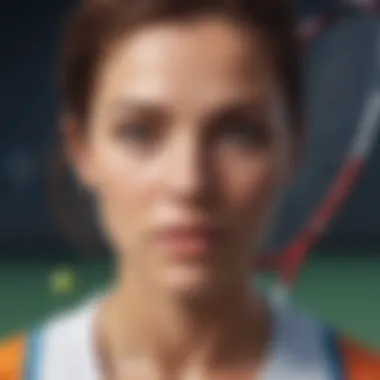
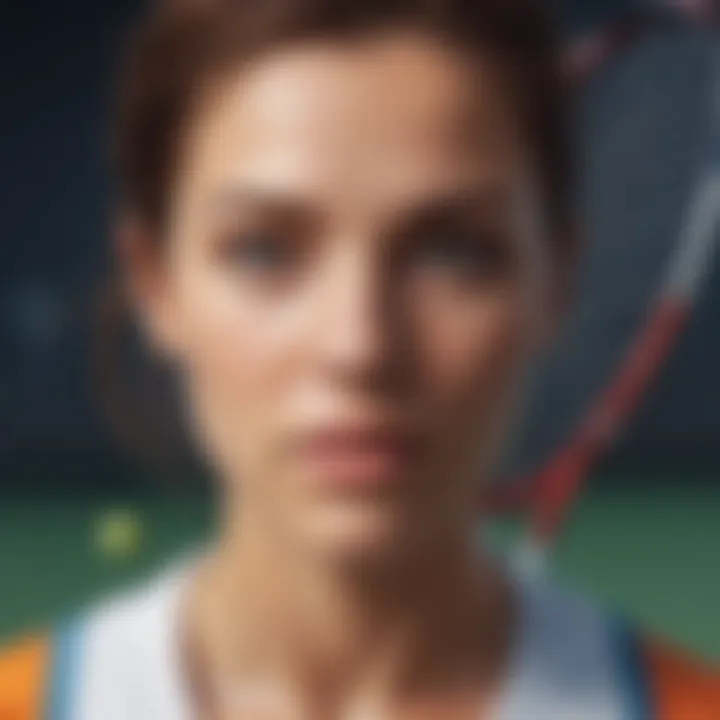
On the other hand, unconscious learning is almost like a hidden treasure. It arises from repetition, ingrained practice, and experiences that shape our responses without us having to consciously think about them. In tennis, this means muscle memory. When a player repeatedly practices serves or volleys, these actions become second nature. So much so that they can focus on the game itself rather than the mechanics.
Here are some key aspects to consider in navigating the dynamics of conscious and unconscious learning:
- Awareness Balance: Knowing when to shift focus from conscious thought to instinctual response.
- Feedback Loop: Utilizing immediate feedback from performance to inform conscious adjustments, which then can refine unconscious skills.
- Repetition: Practicing skills enough until they bypass the conscious mind and become part of the repertoire.
- Mindset: Fostering a mindset that embraces both learning phases, allowing each to contribute its strengths.
The Role of Conscious Thought
Conscious thought in tennis serves as a tool of precision and awareness. When players consciously think about their technique, they can make immediate adjustments. This may involve tinkering with stroke angles, foot positions, or even how to read an opponent’s body language. For instance, understanding the physics of the ball and its trajectory can give a player that edge when deciding to go for a drop shot or a deep baseline return.
But here lies the rub: focusing too hard on mechanics can lead to tension and poor execution. The body, when tied up in knots of conscious computation, often falters at the moment it should shine. To thrive, it's essential to strike a balance. Players must blend the conscious awareness of their body with the flow of the game. The mind should guide, not hinder.
Harnessing the Power of the Unconscious
Tapping into the power of the unconscious can be a game changer. When you're in the zone, or as they say, in the flow, your mind might seem like it's turned off. Yet, paradoxically, it's at this moment that some of the most profound performances happen. For instance, when a player practices serving thousands of times, it’s the repetition that makes that action subconscious. This approach liberates the mind from being stifled by over-analysis.
To harness this power, there are several techniques that can be beneficial:
- Visualization: Picture yourself executing a perfect shot without interference from anxiety or doubt. This lays down pathways in your subconscious, priming your body to respond accordingly.
- Mindfulness Practice: Engaging in mindfulness can help quiet the conscious chatter, allowing the unconscious to come forth. Simple breathing exercises before a match can provide a mental reset.
- Deliberate Practice: Focus on perfecting a specific skill within a match setting while letting your instinct take over other elements – this builds that carefree response we're often chasing.
In summary, understanding the dance between conscious and unconscious learning equips athletes to not just perform, but to thrive. Tennis players who master this duality don’t merely react; they respond intuitively, confidently, and effectively.
The Importance of Focused Attention
In any sport, and particularly in tennis, the ability to direct one’s attention can make or break performance. Focused attention allows athletes to hone in on critical aspects of their game, such as the ball's trajectory, their opponent’s movements, and even their own body mechanics. The impact of maintaining concentration cannot be overstated; it is the thread that weaves together mental agility and physical execution. When players learn to cultivate this focus, they find themselves operating not just at their best, but often in a state of flow where time seems to dissolve and instinct takes over.
Techniques for Enhancing Focus
Improving focus is like sharpening a blade; it requires practice and the right techniques. Different methods can cater to individuals, so it's valuable to explore a range of strategies:
- Establishing Rituals: Players often benefit from developing pre-match routines. These rituals create a sense of familiarity and signal the body that it's time to concentrate. Whether it's a specific warmup or a moment of quiet, establishing these patterns can lay a strong foundation for focused play.
- Mindfulness Exercises: Practices like meditation or yoga can enhance one's ability to remain present. Spending a few minutes in a meditative state can help clear the mental clutter, ensuring that only the essential elements enter the mental arena during a match.
- Breathing Techniques: A common tool among athletes is the practice of deep breathing. Concentrating on inhaling through the nose and exhaling through the mouth can center the mind and redirect attention to the present moment.
- Visualization: Visualization is another powerful technique. Athletes can imagine themselves in successful scenarios, which not only builds confidence but also locks the mind into what needs to be done to achieve that success.
All of these techniques require commitment, akin to training muscles. Developing focus can be a game changer, enabling athletes to maintain composure under pressure and repel distractions the way a wall keeps out the wind.
Directing Attention During Performance
During performance, the real test of focus comes into play. This is about more than simply paying attention; it’s about learning to direct that attention effectively.
- Prioritize Key Elements: Athletes must learn to identify what they need to focus on at any moment. Whether it’s the opponent’s stance, the spin on the ball, or their own footwork, prioritizing this information stream can enhance decision-making processes.
- Employ Selective Attention: A practical technique, selective attention allows players to filter out the surrounding noise. In the heat of a match, this might mean tuning out the crowd's cheers or jeers, concentrating solely on the task at hand.
- Set Short-Term Goals: Instead of overwhelming oneself with the entirety of the match, focusing on short, attainable goals can create a roadmap to success. Players might concentrate on winning the next point or executing a specific play, which reduces anxiety and clarifies intention.
"The crucial factor is not how you prepare but how you remain focused while performing. It’s the difference between losing yourself in the game or owning it."
Overcoming Self-Doubt
The topic of overcoming self-doubt holds immense significance in the context of the Inner Game framework proposed by W. Timothy Gallwey. Many athletes and non-athletes alike grapple with this internal struggle, which often obstructs performance and hinders personal development. At its core, self-doubt manifests as a psychological barrier, gripping players in moments of crucial decision-making on the court or in life.
Individuals can experience a whirlwind of negative thoughts, questioning their abilities with phrases like, "Can I really hit that shot?" or "What if I fail?" This creates a mental fog that clouds judgment and hampers execution, which ultimately leads to subpar results. Overcoming self-doubt is not just about boosting confidence; it’s about unlocking a more authentic version of oneself. Players who break free from these shackles discover newfound clarity, allowing them to engage with their game—and life—more fully.
The Mental Barriers to Performance
In competitive sports, mental barriers like anxiety and fear can create walls between an athlete and their peak potential. For example, consider a tennis player preparing for an important match. If thoughts clouded by fear plague their mind—thoughts such as, "What if I embarrass myself?"—these mental barriers can elevate stress, leading to physical mistakes. It is critical to identify such barriers to mitigate their impact.
"The only thing standing between you and your goal is the story you keep telling yourself as to why you can’t achieve it."
— Jordan Belfort
Mental barriers can include:
- Fear of Failure: The nagging voice that insists that falling short is unfathomable.
- Comparison with Others: Constantly measuring oneself against peers can erode one’s self-esteem.
- Perfectionism: The pursuit of flawlessness can lead to paralysis, stifling creativity and spontaneity.
- Past Experiences: Previous failures can haunt the psyche, making a player hesitant.
Addressing these barriers start by acknowledging their existence in the first place. Only then can strategies be formulated to dismantle them.
Strategies for Building Confidence
Building confidence is a multifaceted journey that requires deliberate action and introspection. Here are some practical strategies embraced by those familiar with the Inner Game:
- Set Achievable Goals: Begin with small, realistic goals that lead toward larger aspirations. This creates a series of successes to draw upon.
- Embrace Mistakes: Rather than fearing them, see mistakes as learning opportunities. Reframing failure can lead to richer experiences and breakthroughs.
- Positive Self-talk: The narrative one tells oneself is crucial. Instead of, "I can’t do this," shift to a more supportive, "I am learning, and that’s okay."
- Visualize Success: A key aspect of the Inner Game is visualization. Picture oneself succeeding. This trains the brain to recognize success as a feasible reality.
- Mindfulness Practices: Engaging in mindful meditation aids in centering thoughts and reducing negative spirals. It invites clarity amidst chaos.
To summarize, overcoming self-doubt involves peeling back the layers of mental barriers and nurturing one's inherent abilities. Through recognized strategies and a deeper understanding of one's inner workings, individuals can shift from a mindset of limitation to one of possibility.
The Role of Visualization
Visualization, often called mental imagery or mental rehearsal, stands as a cornerstone not only in sports performance but also in a broader life perspective. In the context of tennis, it serves as a powerful tool that helps athletes replicate their desired outcomes in the mind before physically executing the actions. Whether you are an amateur or a seasoned pro, incorporating visualization into your training can yield significant advantages, sharpening both mental acuity and physical prowess.
The benefits of visualization are manifold. Practicing this technique can lead to improved focus, reduced anxiety, and enhanced overall performance. Individuals have reported finding clarity and confidence in their play after spending time picturing themselves in successful scenarios. It’s like having a rehearsal in the mind—efficient and tailored to your specific needs.
"Visualization is not just about seeing; it’s about experiencing."
By painting a vivid picture of success in one’s mind, athletes can stay calm under pressure. This skill also conveniently extends beyond the tennis court, influencing various aspects of life, from preparing for a job interview to public speaking. Understanding how to integrate visualization can set the stage for tackling challenges with poise.
Visualizing Success in Sports and Life
Visualizing success involves creating detailed mental images of achieving specific goals. In tennis, this could mean picturing yourself nailing a serve or winning a critical match. When individuals visualize their success in intricate detail—like the sound of a racket, the feel of the ball, or the spectators’ cheers—these mental images become pathways for achieving those outcomes in real life.
- Improved Performance: One of the most notable benefits is the way it enhances technical skills. Studies suggest that athletes who incorporate visualization into their training tend to perform better than those who don't. When one envisions executing a forehand stroke successfully, the brain processes that thought similarly to actually performing it.
- Managing Anxiety: Sports can be a pressure cooker, especially during high-stakes games. Visualization helps alleviate anxiety, as it puts the mind at ease by familiarizing it with the situation. Athletes often feel less stressed because they’ve mentally prepared for the environment they’re stepping into.
- Enhancing Motivation: Imagining success fuels the desire to put in the hard work required. Visualizing the rewards of one’s effort can reinforce commitment, making one more likely to train regularly and strive for improvement.
Implementing Visualization Techniques
Implementing effective visualization techniques requires practice and intention. Below are some strategies to harness the power of visualization effectively:
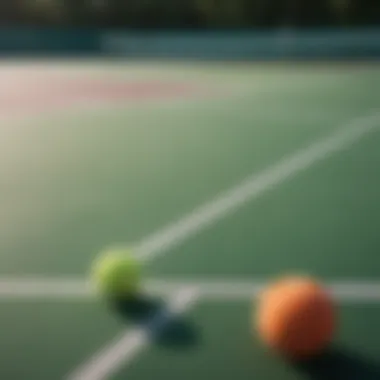
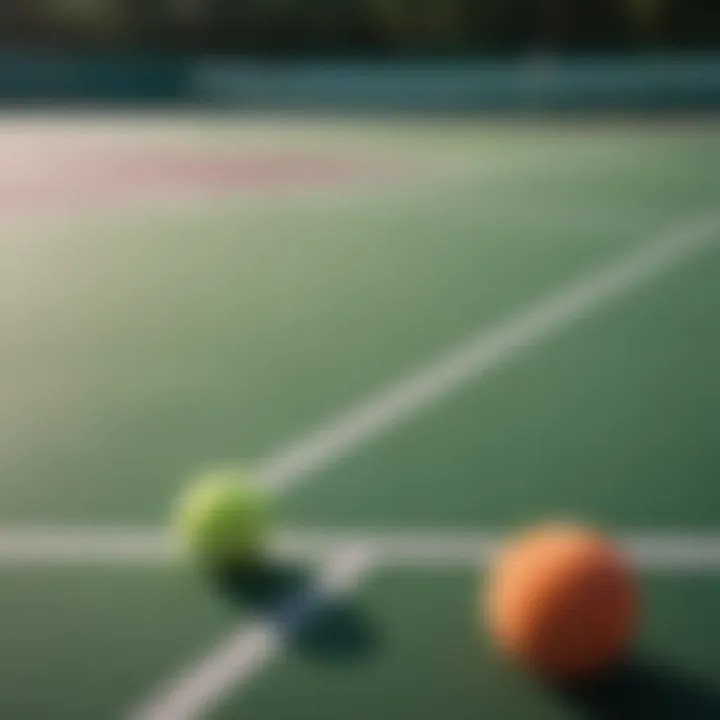
- Choose a Quiet Environment: Find a tranquil space where you won’t be disturbed. This allows you to focus completely on the imagery you are creating in your mind.
- Engage All Senses: Rather than just seeing in your mind’s eye, try to include all senses. Hear the thud of the tennis ball, feel the grip of the racket, and taste the sweat on your brow. The more vivid and sensory-rich your visualization, the better.
- Set Specific Goals: It helps to be clear about what you want to visualize. Whether it’s winning a set or improving your serve, having a purpose directs your mental rehearsal.
- Practice Regularly: Visualization should be a regular part of both practice and preparation. Just like physical training, this mental exercise helps ease into success.
- Journaling Progress: Keeping track of your visualization practice can be enlightening. Note the emotions felt during visualization and compare them with actual performances to see improvements.
By solidifying these techniques into your routine, you can create a mental blueprint for success that’s as real as any practice on the court. Visualization can potentially reshape not just athletic outcomes, but also the way you approach life’s many hurdles.
Trusting the Body's Natural Ability
In the realm of tennis, as in many sports, the importance of trusting one's body cannot be overstated. This concept goes hand in hand with the Inner Game philosophy, which emphasizes the mental components behind physical performance. Central to enhancing athlete experience and results is the ability to step back and acknowledge the body's instincts, rather than solely relying on incessant conscious thought.
When athletes trust their body’s natural ability, they tap into an intuitive reservoir of skills and experiences. Instead of forcing every move, they allow their actions to flow, leading to a more fluid game. This trust reduces anxiety and hesitation, two formidable foes that can hinder performance. By fostering a deeper connection with their own physicality, players often find themselves responding more naturally during matches, enabling them to maintain focus and poise even in high-pressure situations.
Identifying Natural Movements
Recognizing how the body naturally moves is pivotal in trusting its capabilities. Identifying these movements often requires a period of conscious observation. Understanding one’s unique physical attributes can greatly enhance gameplay. For example, some players might have a naturally powerful serve or an instinctive backhand that feels effortless. These strengths become the foundation upon which skills are built, rather than forcing techniques that may not align with an athlete's innate abilities.
Engaging in training that emphasizes these natural movements is equally important. Drilling skills that accentuate one’s core competencies allows for deeper learning and mastery. For instance, a player might focus on how their body aligns during a stroke instead of adhering strictly to methods prescribed by coaches. This can manifest in several ways:
- Observation during practice: Players can record sessions and analyze their natural reactions to different plays.
- Mindful repetition: Emphasizing technique without overthinking often leads to improvement.
- Feedback loops: Pairing with partners to exchange constructive feedback on movements can yield insightful revelations about personal style and tendencies.
Letting Go of Control
A significant hurdle many athletes face is the compulsion to exert control over every playing element. This urge stems from a fear of failure or making mistakes. However, letting go of control does not imply abandoning ambition; rather, it allows one to embrace the uncertainties that come with competition. Athletes should understand that the body, if sufficiently trained, possesses a form of wisdom in its muscle memory that can be relied upon in critical moments.
To let go effectively, players might practice mindfulness techniques. Breathing exercises or focused meditation sessions can help quiet the mind, pushing aside the excess clutter of thoughts that often lead to self-doubt. A clear mind enables players to respond to the game’s dynamics rather than overthink their actions.
Adopting a more relaxed approach may look like:
- Embracing improvisation: In practice, players can allow themselves to hit shots without premeditated plans, seeing where their body takes them.
- Accepting imperfections: Understanding that mistakes are part of the process can empower a player to act freely rather than fearfully.
- Fostering patience: Reminding oneself that skill development is gradual can ease the pressure to perform perfectly.
Trust in the body’s ability brings a new level of confidence, allowing performance to become more instinctive and less methodical.
By nurturing this balance of trust and letting go, tennis players can navigate their game with greater finesse. More importantly, the principles of trusting the body's natural ability extend well beyond the sideline, offering valuable lessons applicable in various walks of life.
Mindfulness and its Applications
Mindfulness has emerged as a vital practice in both sports and daily life, serving as a bridge between mental clarity and physical performance. Within the framework of the Inner Game of Tennis, mindfulness emphasizes awareness and presence. When players practice mindfulness, they become more in tune with their instincts, emotions, and bodily sensations. This heightened awareness can lead to improved focus, reduced anxiety, and ultimately, better performance under pressure.
Several elements forge the importance of mindfulness in this context:
- Enhanced Focus: Players learn to concentrate on the moment rather than dwelling on past mistakes or future outcomes.
- Reduced Anxiety: Mindfulness helps manage the stress and pressure inherent in competitive sports.
- Improved Self-Reflection: By being present, players can more accurately assess their strengths and weaknesses without bias.
Integrating Mindfulness into Training
Bringing mindfulness into training is not merely about practicing meditation. It can be seamlessly woven into exercises and routines. Here are practical steps for athletes looking to integrate mindfulness:
- Breathing Exercises: Start each practice with a few minutes of focused breathing to center the mind.
- Mindful Drills: Engage in drills while consciously paying attention to each movement, whether it's serving or volleying. This awareness can help players connect with their bodies more deeply and perform more fluidly.
- Reflection Sessions: After training, athletes can spend time reflecting on what they experienced, focusing on sensations and thoughts.
Mindfulness in training builds a foundation where players can rely on instinct and technique with greater ease. It cultivates an environment where learning becomes organic rather than forced.
Benefits Beyond the Court
The applications of mindfulness extend far beyond the tennis court. The benefits spill into various aspects of life for both athletes and non-athletes alike. Here’s how:
- Stress Management: Mindfulness techniques can equip individuals to handle life's stresses with composure, aiding in everything from personal relationships to work environments.
- Enhanced Emotional Regulation: Regular mindfulness practice fosters greater emotional resilience, allowing individuals to navigate frustrations and disappointments without losing control.
- Better Decision Making: By sharpening focus and clarity, mindfulness helps people in making decisions with thoughtfulness rather than reactively.
"Mindfulness is not about trying to get somewhere else. It’s about being where you are and realizing that it’s enough."
As players embrace mindfulness, they unlock a treasure trove of benefits. The effects ripple outward, creating positive changes in their interactions, productivity, and emotional well-being.
Applying the Inner Game Principles
In the realm of sports, and indeed in numerous facets of life, the ability to harness mental strength forms a bedrock for success. When it comes to the concept of the Inner Game, the principles laid out by W. Timothy Gallwey possess far-reaching implications that extend well beyond the tennis court. Each principle fosters self-awareness and promotes confidence, both of which are crucial in achieving peak performance. By adopting these principles, athletes can not only enhance their skills but also navigate life's challenges with a grounded perspective.
Transference to Other Sports
The Inner Game principles can seamlessly transition to diverse sports disciplines. Athletes, regardless of their specialty — basketball, soccer, or swimming — can benefit from developing focused attention, self-awareness, and the ability to trust their instincts. For instance, a soccer player might leverage visualization techniques to enhance their spatial awareness on the field. Visualization encourages players to mentally rehearse movements, moves, and scenarios, which can be particularly helpful during high-pressure situations.
Similarly, basketball players can engage in mindfulness practices to foster concentration during free throws. Focusing on the rhythm of their breath while eliminating distractions ties into the core of the Inner Game philosophy. Once a player learns to quiet self-doubt and enhance concentration, they tend to perform at a higher level.
"In sports, as in life, the mind often holds the keys to unlocking true potential, if one learns to listen."
Utilizing Concepts in Everyday Life
The wisdom embedded within the Inner Game transcends physical activity, laying a foundation for navigating everyday life scenarios. Practicing self-awareness fosters clarity in decision-making, ensuring individuals remain grounded amid external chaos. Take, for instance, public speaking. By employing techniques such as visualization or breathing exercises, individuals can calm pre-speech jitters, focusing instead on delivering their message with confidence and poise.
Moreover, the principle of trusting our natural abilities finds relevance in professional settings as well. When individuals shift their mindset from worrying about outcomes to focusing on their strengths, they invite success in everything from job interviews to presentations. Here are some practical ways the principles can be applied:
- Mindfulness in Work: Practicing mindfulness during work tasks encourages sustained focus and lowers stress levels, enhancing overall productivity.
- Self-awareness in Relationships: By being attuned to one's thoughts and feelings, individuals can communicate more effectively, fostering healthier relationships.
- Visualization for Goals: Whether it's a personal project or a career aspiration, visualizing success helps in making those dreams more tangible.
Ultimately, the principles of the Inner Game create a blueprint for excellence not just in sports, but also in the everyday journeys we navigate. This systematic approach, informed by self-discovery, promotes holistic development in all spheres of life, emphasizing the intertwined relationship between mind and body.
Critiques and Limitations
In any exploration of psychological frameworks, it’s critical to address critiques and limitations. In the context of W. Timothy Gallwey's Inner Game, understanding these aspects not only highlights the robustness of the concept but also provides a balanced view. It allows practitioners to navigate potential oversights while applying the principles of the Inner Game effectively.
Common Criticisms of the Inner Game Framework


Some critics argue that Gallwey's approach overly simplifies the complexities of competitive sports. They suggest that reducing performance to a mere interplay between two selves—Self One and Self Two—might neglect the multifaceted nature of athletic competition. Competitors are often influenced by external factors such as coaches, teammates, and even the audience. Critics may say, "It’s not just in the mind; the environment plays a huge role too!"
Additionally, some purists within sports psychology question the empirical evidence supporting the Inner Game framework. While many athletes report benefits from visualization and mindfulness, the lack of extensive, quantifiable studies could lead one to believe the concepts are somewhat anecdotal. As one skeptic noted, "Not everything can be solved by thinking better. Sometimes, muscle memory and tactics are what count."
However, it’s important to recognize that these critiques do not inherently diminish the framework’s efficacy; rather, they encourage deeper exploration of both mental and physical aspects of performance. By understanding these criticisms, one can tailor the Inner Game principles to better fit individual circumstances.
Acknowledging the Complexities of Performance
As athletes know well, performance is seldom a straightforward journey. Acknowledging the complexities of performance involves recognizing varying factors that influence an athlete's ability to execute skills under pressure. Physical conditioning, tactical decisions, and mental resilience all intersect, making achievement a layered experience.
Incorporating the Inner Game principles requires a nuanced understanding of this complexity. For instance, just focusing on harnessing Self Two through trust might not suffice if an athlete is low on physical stamina or is facing a particularly skilled opponent. The Inner Game can act as a complement to other strategies, certainly, but it should not stand alone as a cure-all.
Moreover, emotional states such as anxiety or excitement can skew how one interprets their performance. Failure to acknowledge these emotional nuances can sometimes lead to frustration, especially when mental strategies don’t yield expected results. It’s essential for individuals to recognize when they might need to integrate other training methods or mental strategies alongside the Inner Game.
By weaving together the principles of Gallwey’s framework with a holistic awareness of personal performance dynamics, athletes can cultivate a richer understanding that not only embraces the mental elements but also acknowledges the tactical, emotional, and physical components that are equally pressing in the heat of competition.
"Mastering the mind is just one part of the game; the body has to follow suit."
In rounding out this critique and acceptance of limitations, a balanced exploration of the Inner Game fosters a deeper appreciation for both its strengths and its boundaries. Recognizing these layers only serves to enhance how the framework can be utilized, making it a more comprehensive tool for shaping performance.
Personal Reflections and Insights
In the exploration of the Inner Game, personal reflections stand out as a significant avenue for individual growth and understanding. Engaging with one's own experiences often unveils a wealth of insights that can be applied on and off the tennis court. The importance of personal reflections lies in their ability to foster self-awareness, allowing players—or anyone striving for improvement—to connect more deeply with their mental processes, emotions, and reactions.
Lessons Learned Through Practice
Having an opportunity to apply the principles from W. Timothy Gallwey's teachings brings about valuable lessons, both implicit and explicit. One major lesson that emerges is the understanding of how mindset can dramatically alter performance outcomes. When players reflect on their past matches, they might realize that their best performances were often tied to periods when they were relaxed and trusting their instincts, as opposed to overthinking every play.
Here are a few key takeaways from these reflections:
- Emotional Regulation: Players discover how their emotions can impact their game. When frustration takes the front seat, performance tends to spiral downwards.
- On-the-Fly Adjustments: Reflecting on matches encourages adaptability. Players learn to adjust strategies dynamically, rather than rigidly adhering to a preconceived plan.
- Personal Best: Each athlete recognizes that their journey is unique. Comparisons with others can distract from their own growth; therefore, focusing on personal milestones is critical.
Reflective practices, such as journaling or using a voice recorder to capture thoughts after each session or match, can further solidify these lessons. This not only enhances clarity but cultivates gratitude for progress, no matter how minute it seems at first.
Perspectives from Practitioners
Insights from players who have integrated the Inner Game principles into their routine reveal a tapestry of diverse experiences. For instance, a seasoned coach may point out that nurturing self-trust among players leads to performance breakthroughs. They often say that the moment a player starts believing in the process and their abilities, the results reflect that positivity.
Practitioners also contend with the following:
- Consistent Feedback: Regular and constructive feedback plays a crucial role in the player’s understanding of their own game. This ongoing dialogue promotes adaptation and learning from one's errors.
- Cohesion in Teams: Sharing personal experiences within teams can build trust and open lines of communication, ultimately enhancing group dynamics both on and off the court.
- Holistic Approach: Many emphasize the need for a well-rounded mindset that includes physical training, mental exercises, and emotional well-being. Integrating mindfulness, for example, shifts focus away from mere scores to the sheer joy of playing, which is often lost in competitive environments.
"It's not just about hitting the ball; it's about being in the moment while doing it."
— A seasoned tennis coach
Capturing insights derived from both personal experiences and those of other practitioners enriches one’s own journey, providing a broader understanding of the Inner Game and its manifold applications. Such perspectives not only help refine techniques on the court but also encourage a fulfilling approach to life overall.
The Legacy of the Inner Game
The legacy of the Inner Game transcends its initial focus on tennis, permeating various fields and disciplines, and igniting a rethinking of performance enhancement. W. Timothy Gallwey's principles laid the groundwork for a nuanced understanding of how mental states influence bodily actions. This importance cannot be overstated; individuals who grasp the inner game concepts unlock not merely better athletic performances but also enriched lives informed by self-awareness and mindful engagement.
Influence on Modern Sports Psychology
The impact of Gallwey's ideas on contemporary sports psychology is akin to throwing a pebble into a pond, creating ripples that extend far beyond the surface. His work nudged practitioners to pay closer attention to the mental aspects of sports performance, identifying that physical skills alone do not determine success. Elements such as motivation, confidence, and concentration—once thought secondary—are now recognized as critical contributors to performance.
- One significant area of change is in coaching. Traditional coaching methods often emphasized telling athletes what to do and how to do it. However, the Inner Game approach advocates for guiding athletes to discover their own answers. This highlights the value of autonomy and self-discovery, a refreshing shift from the old, directive style of coaching.
- Furthermore, mental imagery and visualization have grown in significance. Athletes are now instructed not merely to practice physical skills but to visualize their performance in equal measures. This technique aligns seamlessly with Gallwey's teachings, supporting the belief that mental rehearsal can enhance execution on the field.
- Mindfulness, which draws heavily from the concepts in the Inner Game, has found its way into sports psychology practices as well. This emphasis encourages athletes to remain present, reducing anxiety and enhancing performance.
As a result, many athletic programs emphasize psychological preparation alongside physical training—proof that the legacy of the Inner Game continues to inspire innovations in how athletes train and compete.
Cultural Impact Beyond Tennis
The Inner Game's influence stretches far beyond the confines of tennis courts, reaching into various cultural arenas. It would be remiss to underestimate the impact on personal development and self-help movements. Concepts borrowed from Gallwey's work have become principles for improving one’s mindset in daily life situations—structured around overcoming self-doubt, embracing failure, and enhancing focus.
- For instance, corporate settings have embraced the Inner Game teachings to foster leadership and teamwork. Companies now understand the importance of self-awareness and emotional intelligence in building cohesive teams. Improved communication and understanding individuals' inner workings can be directly traced back to these principles of self-discovery articulated by Gallwey.
- Education also reflects this cultural shift. Teachers now explore methods that encourage student autonomy, promoting engagement through self-directed learning. Classes increasingly incorporate mindfulness practices and visualization techniques to foster a more conducive learning environment, illustrating the pervasiveness of these ideas.
Through its significant cultural penetration, the legacy of the Inner Game prompts individuals to rethink their approaches to conflict, growth, and motivation in numerous arenas.
"You do not need to be in a performance environment to engage with the Inner Game. It’s useful in any area of life where performance is essential."
This kind of pervasive relevance underscores Gallwey's vision—offering tools not just for sports enthusiasts but for anyone who seeks self-improvement and heightened awareness. In exploring the legacy of the Inner Game, it becomes clear that its implications are not only about playing better tennis but about fostering a more robust understanding of ourselves and our interactions with the world.
Finale: The Enduring Relevance
As we wrap up our exploration into the Inner Game of Tennis, it becomes clear that the ideas extended by W. Timothy Gallwey are not just limited to the sport itself. No, they resonate well beyond the confines of tennis courts. This framework offers a lens through which one can view performance, learning, and personal growth in various aspects of life.
Specific Elements and Benefits
The integral themes of self-awareness and focused attention shine brightly in this context. In a world where distractions loom large, having the ability to maintain concentration becomes imperative. The mental exercises derived from understanding the interactions between Self One and Self Two provide not just athletes but anyone striving for excellence with tools to dismantle the mental barriers that can hinder performance.
The benefits of applying these concepts are plentiful. For instance, athletes can optimize their skills, educators can foster enhanced learning in the classroom, and individuals can approach challenges in personal and professional domains with newfound confidence. Even in high-pressure job environments, the principles of the Inner Game can lead to improved decision-making and execution.
Considerations About Enduring Relevance
Furthermore, the cultural impact of these teachings has permeated the fabric of modern sports psychology. The awareness of one’s internal dialogue has been highlighted significantly in various self-help movements, indicating a growing recognition of the necessity for mental strength. This “inner game” is no longer confined to tennis but rather, firmly established as a universal principle of performance enhancement.
"The real game is a mental game, a game played with your own mind."
– W. Timothy Gallwey
Incorporating the lessons learned from the Inner Game not only offers practical applications but promotes a shift in mindset vital for sustained growth and success.
Summarizing Key Takeaways
- Self-Awareness: Understanding one's internal dialogues can significantly influence performance.
- Focus: The ability to concentrate and leverage one’s subconscious moves can promote excellence.
- Transference: Concepts learned from tennis can be applied across fields like education, business, and beyond.
Encouraging Continued Exploration
As we reflect upon the lasting relevance of the Inner Game, it's crucial to dig deeper into its applications. Embrace the mental tools offered in this narrative and make them a part of daily practice.
Engagement with these principles can be a transformative experience, whether through reading further on Gallwey’s approaches or discussing with peers who may share the journey. Resources like en.wikipedia.org and britannica.com provide foundational knowledge to further broaden understanding. Moreover, engaging in online communities, for example on platforms like reddit.com, allows for the exchange of ideas and experiences that can fuel personal growth even further.
In sum, maintaining an open mind and being curious about the inner workings of our performance could lead to profound insights. The journey doesn't stop here; it’s just the beginning.







